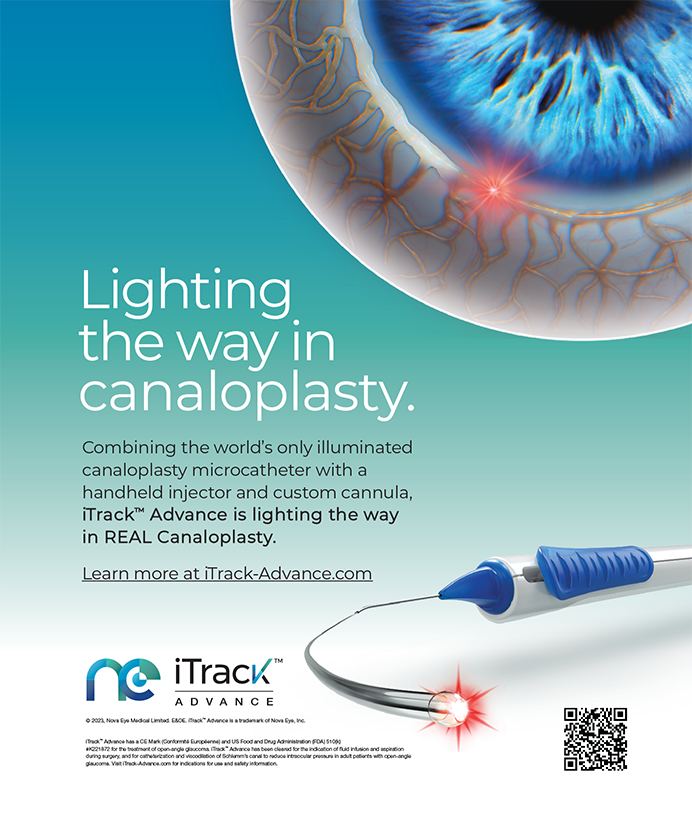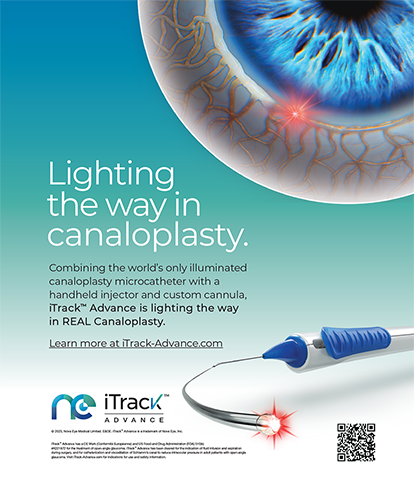A new supracapsular technique for phacoemulsification surgery, Phaco Tilt, significantly decreases the risk of a posterior capsular rupture and allows for maximal surgical efficiency. Phaco Tilt is reproducible and independent of pupil size and lens density, and it causes less endothelial trauma than flipping techniques.
I use topical 2% lidocaine but I frequently add an inferior “mini-block” with 1 to 2 mL of 1% lidocaine to minimize lid squeezing. My approach is temporal with a simultaneous creation of a paracentesis site (using a 1-mm diamond knife) and a clear-cornea wound entry (using a 2.7- to 3.2-mm tapered black diamond knife). If additional anesthesia is needed, I will instill 0.2 mL nonpreserved 1% intracameral lidocaine via the paracentesis site.
Next, I inject Ocucoat (Storz, St. Louis, MO) through the wound to fill the anterior chamber, and I place a little of the viscoelastic on the corneal surface. Due to its adherent properties, Ocucoat protects the endothelium better than other viscoelastics, and I find it reduces the potential for corneal folds postoperatively with hard nuclei. In addition, I use a small amount of Amvisc Plus (Bausch & Lomb, San Dimas, CA). An Ocucoat/Amvisc Plus “sandwich” can help with more difficult cases, such as small pupils and white cataracts, that require more stability in the anterior chamber. This technique provides better control for difficult capsulotomies and creates no visible viscoelastic interface line. I have found that Ocucoat enables me to create a capsulotomy tear rapidly. It also maintains excellent clarity when placed on the cornea externally, thereby eliminating the need for constant irrigation and decreasing the incidence of the blink/squeeze reflex that irrigation incites.
I then perform a continuous-tear circular capsulotomy 5 to 6 mm in diameter, followed by hydrodissection with the cannula tip placed far in the periphery. The Phaco Tilt technique is not dependent on vigorous hydrodissection, which averts the possibility of iris prolapse in shallow chambers.
THE MANIPULATOR
I rely on the Grayson Nucleus Manipulator (Bausch & Lomb) to hold the wound open as I insert the phaco probe. I find that it allows me to use instrumentation more efficiently, and avoid lacerating the wound or stripping Descemet's membrane while introducing the probe into the anterior chamber.
In my experience, Bausch & Lomb's Millennium is the most efficient phaco unit, with rapid vacuum build and release for phaco and irrigation/aspiration in Venturi mode. It also has a controlled linear vacuum build and rapid release for phaco and I/A in Concentrix mode. In addition, I appreciate the machine's extremely versatile, software-programmable foot pedal control. Efficient heat dissipation at the probe virtually eliminates the risk of phaco burn, and the Millennium has full anterior and posterior vitrectomy capabilities.
LIFT AND TILT THE NUCLEUS
I designed the manipulator with a spatula section featuring a rounded contour edge in order to decrease the risk of a posterior capsular rupture. When I introduce the instrument via the paracentesis site, the manipulator's angle of inclination enables me to lift and tilt the nucleus efficiently (Figure 1). I use the hooked section with a contoured inner edge to rotate the nucleus and safely pull the capsular rim or iris to facilitate I/A and lens insertion.
Next, I slide the spatula section of the manipulator downward at the capsular rim nearest to the paracentesis site and under the edge of the nucleus, which I sweep under and lift. I tilt the nucleus so that approximately half is in the capsular bag and half just above the iris plane. I then emulsify the nuclear half just above the iris plane, while ensuring that the phaco tip is always clear of the posterior capsule. Using the hooked section of the manipulator, I proceed to rotate the remaining nuclear half to just above the iris plane and complete the emulsification (Figure 2).
I perform I/A of all cortical remnants and polish the posterior capsule as needed. The manipulator can be used to help mobilize the epinuclear plate (if present). After inflating the capsular bag with Ocucoat, I enlarge the wound to 3.3 to 3.4 mm using a black diamond keratome.
Using the manipulator at the paracentesis site to stabilize the globe, I then introduce an H60M Hydroview IOL (Bausch & Lomb) into the capsular bag. The H60M uses new hydrophilic acrylic technology that results in less postoperative inflammation overall and a lower rate of posterior capsular opacity. The haptics, composed of PMMA, are fused to the IOL, which allows the IOL to be one piece.
Next, I remove the residual viscoelastic with I/A and hydrate the temporal wound with BSS (Alcon Laboratories, Fort Worth, TX) through a cannula. It is important to maintain the anterior chamber depth without obvious leakage. Wound hydration can also help dislodge any small nuclear chips stuck in the paracentesis site or at the wound's edge.
Finally, I place topical Tobradex drops (Alcon Laboratories) on the eye. Usually, no patch or shield is necessary. Sub-Tenon's steroids may be given in the presence of a previous filtering bleb, uveitis, known cystoid macular edema in the fellow eye, or poor compliance with drops.
Phaco Tilt, particularly using the Grayson Nucleus Manipulator, is an efficient, effective, and safe supracapsular technique for contemporary phacoemulsification cataract surgery.Douglas K. Grayson, MD, FACS, is an Assistant Clinical Professor of Ophthalmology at The New York Eye and Ear Infirmary and Medical Director of Omni Eye Services of Iselin, New Jersey and New York, NY. He may be reached at (212) 686-1313; douglas.grayson@verizon.net. Dr. Grayson does not hold a financial interest in any of the products mentioned herein and is not a paid consultant for Bausch & Lomb. Material extracted from the Bausch & Lomb Innovators' Series presented at the November 2001 AAO meeting in New Orleans, Louisiana.


